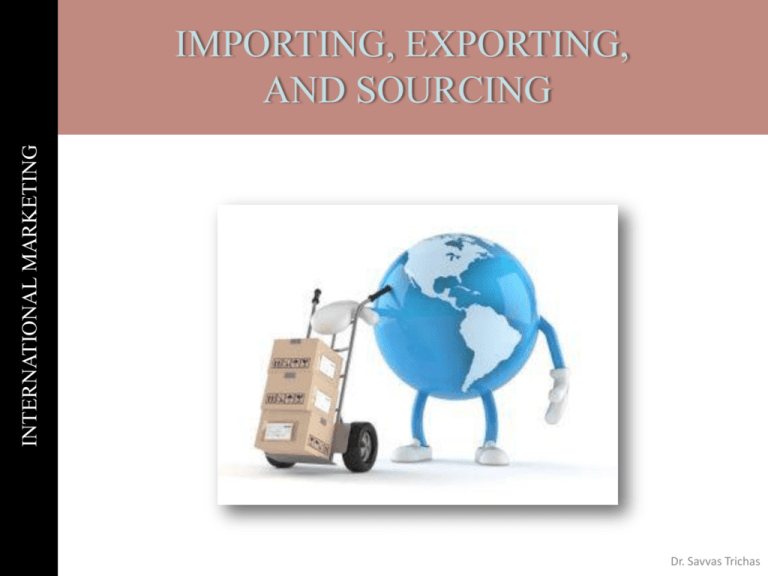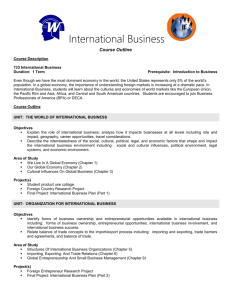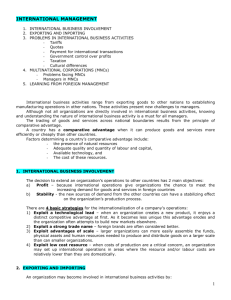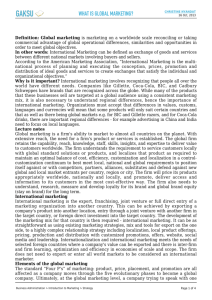IMPORTING, EXPORTING, AND SOURCING
advertisement

INTERNATIONAL MARKETING IMPORTING, EXPORTING, AND SOURCING Dr. Savvas Trichas INTERNATIONAL MARKETING IMPORTING, EXPORTING, AND SOURCING Importing, exporting, and sourcing Europe is famous as a source for fine leather goods such as handbags and shoes. Each year, consumers in Europe buy 2.5 billion pairs of shoes. Shoes from China currently account for about 1/3 of the market; since 2001, when China joined the WTO, Chinese imports have increased ten-fold. Imports from Vietnam have doubled in the same period. Dr. Savvas Trichas INTERNATIONAL MARKETING IMPORTING, EXPORTING, AND SOURCING Importing, exporting, and sourcing The flood of shoe imports from China and Vietnam has been a boon for European retailers and value-conscious consumers. However, faced with a threat to their business, manufacturers in Italy, Spain, and France sought protection. In an effort to curb the tide of imports, the European Commission imposed tariffs for a period of two years: 16.5% on shoes from China and 10% on shoes from Vietnam. The narrow margin on victory for the tariffs reflects divergent views in Europe about how to deal with low-cost Asian goods. Dr. Savvas Trichas INTERNATIONAL MARKETING IMPORTING, EXPORTING, AND SOURCING Export selling It does not involve tailoring the product, the price, or the promotional material to suit the requirements of global markets. The only marketing mix element that differs is the “place”; that is, the country where the product is sold. Dr. Savvas Trichas INTERNATIONAL MARKETING IMPORTING, EXPORTING, AND SOURCING Export marketing It targets the customer in the context of the total market environment. The export marketer does not simply take the domestic product “as is” and sells it to international customers. It is the integrated marketing of goods and services that are destined for customers in international markets. Dr. Savvas Trichas INTERNATIONAL MARKETING IMPORTING, EXPORTING, AND SOURCING Export marketing It requires: An understanding of the markets of the target market environment. The use of marketing research and identification of market potential. Decisions concerning product design, pricing, distribution and channels advertising, and communications. Dr. Savvas Trichas INTERNATIONAL MARKETING IMPORTING, EXPORTING, AND SOURCING Market visit It should confirm (or contradict) assumptions regarding market potential. Gather additional data necessary to reach the final go or no-go decision regarding an export marketing program. Certain kinds of information simply cannot be obtained from secondary sources. Develop a marketing plan in cooperation with the local agent or distributor. Dr. Savvas Trichas INTERNATIONAL MARKETING IMPORTING, EXPORTING, AND SOURCING National policies governing exports and imports For centuries, nations have combined two opposing policy attitudes toward the movement of goods across national boundaries. On the one hand, nations encourage exports, the flow of imports, on the other hand, they are generally restricted. Dr. Savvas Trichas INTERNATIONAL MARKETING IMPORTING, EXPORTING, AND SOURCING Government programs that support exports Any government concerned with trade deficits of economic development should focus on educating firms about the potential gains from exporting. This is true at the national, regional, and local government levels. Governments commonly use four activities to support and encourage firms that engage in exporting. These are tax incentive, subsidies, export assistance, and free trade zones. Dr. Savvas Trichas INTERNATIONAL MARKETING IMPORTING, EXPORTING, AND SOURCING Tax incentives Treat earnings from export activities preferentially either by applying a lower rate to earnings from these activities or by refunding taxes already paid on income associated with exporting. The tax benefits offered by export conscious governments include varying degrees of tax exemption or tax deferral on export income, accelerated depreciation of exportrelated assets and generous tax treatment of overseas market development activities. Dr. Savvas Trichas INTERNATIONAL MARKETING IMPORTING, EXPORTING, AND SOURCING Subsidies Direct or indirect financial contributions or incentives that benefit producers. Dr. Savvas Trichas INTERNATIONAL MARKETING IMPORTING, EXPORTING, AND SOURCING Governmental assistance Companies can avail themselves of a great deal of government information concerning the location of markets and credit risks. Assistance may also be oriented toward export promotion. Government agencies at various levels often take the lead in setting up trade fairs and trade missions designed to promote sales to foreign customers. Dr. Savvas Trichas INTERNATIONAL MARKETING IMPORTING, EXPORTING, AND SOURCING Free trade zones The export or import process can entail red tape and bureaucratic delays. This is especially true in emerging markets, such as China and India. In an effort to facilitate exports, countries are designating certain areas as free trade zones or special economic zones. These are geographic entities that offer manufacturers simplified customs procedures, operational flexibility, and a general environment of relaxed regulations. Dr. Savvas Trichas INTERNATIONAL MARKETING IMPORTING, EXPORTING, AND SOURCING Governmental actions to discourage imports and block market access Measures such as tariffs, import controls and a host of nontariff barriers are designed to limit the inward flow of goods. Dr. Savvas Trichas INTERNATIONAL MARKETING IMPORTING, EXPORTING, AND SOURCING Tariffs and duties Tariffs can be thought as the “three R’s” of global business: rules, rate schedules (duties), and regulations of individual countries. Duties can be thought as “taxes that punish individuals for making choices of which their governments disapprove”. Dr. Savvas Trichas INTERNATIONAL MARKETING IMPORTING, EXPORTING, AND SOURCING Tariffs and duties In spite of the progress made in simplifying the tariff procedures, administrating a tariff is an enormous problem. People who work with imports must familiarize themselves with the different classifications and use them accurately. Dr. Savvas Trichas INTERNATIONAL MARKETING IMPORTING, EXPORTING, AND SOURCING Tariffs and duties A product classification can make a substantial difference in the duty applied. For example, is a Chinese-made X-men action figure a doll or a toy? For many years, dolls were subjected to a 12% duty when imported in to the United States; the rate was 6.8% for toys. Moreover, action figures that represent non-human creatures such as monsters or robots were categorized as toys and qualified for lower duties than human figures that the Customs Service classifies as dolls. Duties on both categories have been eliminated. The X-Men toy case went in court and prove that it does not represent humans. Dr. Savvas Trichas INTERNATIONAL MARKETING IMPORTING, EXPORTING, AND SOURCING Nontariff barrier Any measure other than a tariff that is a deterrent or obstacle to the sale of products in a foreign market. Nontariff barriers include quotas, discriminatory procurement policies, restrictive customs procedures, arbitrary monetary policies, and restrictive regulations. Dr. Savvas Trichas INTERNATIONAL MARKETING IMPORTING, EXPORTING, AND SOURCING Quota A government-imposed limit or restriction on the number of units or the total value or a particular product or product category that can be imported. Dr. Savvas Trichas INTERNATIONAL MARKETING IMPORTING, EXPORTING, AND SOURCING Discriminatory procurement policies Government rules and administrative regulations specifying that local vendors or suppliers receive priority consideration. Dr. Savvas Trichas INTERNATIONAL MARKETING IMPORTING, EXPORTING, AND SOURCING Customs procedures They are considered restrictive if they are administered in a way that makes compliance difficult and expensive. Formal disagreements on procedures and product classifications that cost time and money for both the importer and exporter. Dr. Savvas Trichas INTERNATIONAL MARKETING IMPORTING, EXPORTING, AND SOURCING Discriminatory rate policies exchange Distort trade in much the same way as selective import duties and export subsidies. Some claim that China is pursuing policies that ensure an artificially weak currency which results in a competitive price edge in world markets. Dr. Savvas Trichas INTERNATIONAL MARKETING IMPORTING, EXPORTING, AND SOURCING Restrictive administrative and technical regulations These may take the form of antidumping regulations, product size regulations, and safety and health regulations. Dr. Savvas Trichas INTERNATIONAL MARKETING IMPORTING, EXPORTING, AND SOURCING Organizing for exporting in the manufacturer’s country Home-country issues involve deciding whether to assign export responsibility inside the company or to work with an external organization specializing in a product or geographic area. Most companies handle export operations within their own in-house export organization. In such cases responsibilities can be incorporated into job descriptions or as separate division or organizational structure. Dr. Savvas Trichas INTERNATIONAL MARKETING IMPORTING, EXPORTING, AND SOURCING Organizing for exporting in the manufacturer’s country The advantage of including responsibilities into domestic job descriptions is that it is a low-cost option. However, attention is needed in terms of competence of the people that are doing the job as regards products, customer knowledge, and international markets. Dr. Savvas Trichas INTERNATIONAL MARKETING IMPORTING, EXPORTING, AND SOURCING Organizing for exporting in the market country In addition to the latter a company must also make arrangements to distribute the product in the target market country. A decision is needed whether the organization is going to rely on direct market representation as opposed to independent intermediaries. Direct market allows decisions concerning program development, resource allocation, or price changes to be implemented unilaterally. Dr. Savvas Trichas INTERNATIONAL MARKETING IMPORTING, EXPORTING, AND SOURCING Sourcing In today’s competitive marketplace, companies are under intense pressure to lower costs and one way to do this is to locate manufacturing and other activities in China, India, and other low-wage countries. A sourcing decision refers to whether a company makes or buys its products. Outsourcing refers to shifting production jobs or work assignments to another country to cut costs. Dr. Savvas Trichas INTERNATIONAL MARKETING IMPORTING, EXPORTING, AND SOURCING Sourcing Several factors may figure in the sourcing decision: management vision, factor costs and conditions, customer needs, public opinion, logistics, country infrastructure, political factor, and exchange rates. Dr. Savvas Trichas INTERNATIONAL MARKETING IMPORTING, EXPORTING, AND SOURCING Management vision Some chief executives are determined to retain some or all manufacturing in their home country. Dr. Savvas Trichas INTERNATIONAL MARKETING IMPORTING, EXPORTING, AND SOURCING Factor costs conditions and They include land, labour, and capital costs. Labor include the cost of workers at every level: manufacturing and production, professional and technical, and management. For example basic manufacturing direct labour costs today range from less than $1 per hour in a typical emerging country to $6 to $12 per hour in the typical developed country. Dr. Savvas Trichas INTERNATIONAL MARKETING IMPORTING, EXPORTING, AND SOURCING Customer needs Sometimes customers are seeking something besides the lowest possible price. For example Dell’s clients were unhappy with Indian technical support so they went to the higher cost option of moving their call centre back to the United States. Dr. Savvas Trichas INTERNATIONAL MARKETING IMPORTING, EXPORTING, AND SOURCING Logistics In general, the greater the distance between the product source and the target market, the greater the time delay for delivery and the higher the transportation cost. However, innovation and new transportation technologies are cutting both time and money costs. Dr. Savvas Trichas INTERNATIONAL MARKETING IMPORTING, EXPORTING, AND SOURCING Country infrastructure It is important that the basic physical and organizational structures and facilities (e.g., buildings, roads, and power supplies) of a society or enterprise be sufficiently developed to support a manufacturing operation. Consequently, a country may have cheap labour, but may not have supporting infrastructure for the specific manufacturing activity. Dr. Savvas Trichas INTERNATIONAL MARKETING IMPORTING, EXPORTING, AND SOURCING Political factors Political risk is a deterrent to investment in local sourcing. Also, amendments that influence marketing conditions should be considered. Finally, another factor to take in consideration market access issues such us regional limitations, content laws, balanceof-payments problems. Dr. Savvas Trichas INTERNATIONAL MARKETING IMPORTING, EXPORTING, AND SOURCING Foreign exchange rates In deciding where to source a product or locate a manufacturing activity, a manager must take into account foreign exchange trends in various parts of the world. The dramatic shifts in price levels of commodities and currencies are a major characteristic of the world economy today. Such volatility argues for a sourcing strategy that provides alternative country options for supplying markets. Thus, if the dollar, yen, or the mark becomes seriously overvalued, a company with production capacity in other locations can achieve competitive advantage by shifting production among different sites. Dr. Savvas Trichas







